Enterprise software is transforming organizations across the globe. These enterprise solutions allow organizations to adjust to changing market needs. They also equip them with enhanced capabilities that help them adapt to emerging technologies and provide their customers with better experiences.
By adopting enterprise software, organizations can unlock several benefits, including:
- Optimizing their business processes
- Automating workflows
- Enhancing efficiency
- Maintaining their strategic advantage in today’s dynamic and competitive business landscape
From marketing and data analysis to custom application development, enterprise software solutions enable companies to embrace digital transformation and uncover better growth opportunities. Find out how different companies are utilizing enterprise software and how these solutions paved the way for their success.
9 Inspiring Enterprise Software Examples and Success Stories for 2024:
Inspiring Examples of Companies Finding Success with Enterprise Software
Larger enterprises face several significant challenges that hamper progress. These companies tend to have silos, gaps like isolated workflows, and outdated business processes. To overcome these, enterprises need large-scale solutions.
Below, you can learn more about how nine companies used different applications and types of enterprise software for business growth.
Enterprise Project Management Software
Enterprise project management (EPM) software solutions are typically used for workflow management and data analytics. Enterprise teams use these to manage multiple tasks, promote real-time collaboration, eliminate data silos, and enhance efficiency.
1. Wrike and Aerotek

Aerotek is a staffing and service provider with over four decades of experience in the industry. It has 8,000 internal employees, employs 200,000+ contractors, and has 14,000+ clients across North America. These numbers mean a lot of transactions, processes, and communications between various stakeholders. Aerotek realized that it needed a solution that would enable them to accomplish several things:
- Effectively manage their project timelines
- Enhance and streamline collaboration across six marketing department teams
- Act as a central hub for approvals, requests, and more
The company worked with Wrike, a work management platform equipped with enterprise-ready solutions. Working with Wrike enabled Aerotek to:
- Follow a new project management methodology
- Reduce email usage by 85-90%
- Shorten planning cycles and have more effective and strategic meetings
It’s also worth noting that Aerotek’s use of EPM software allowed it to streamline business processes and marketing requests.
2. Wrike and Frontline Education
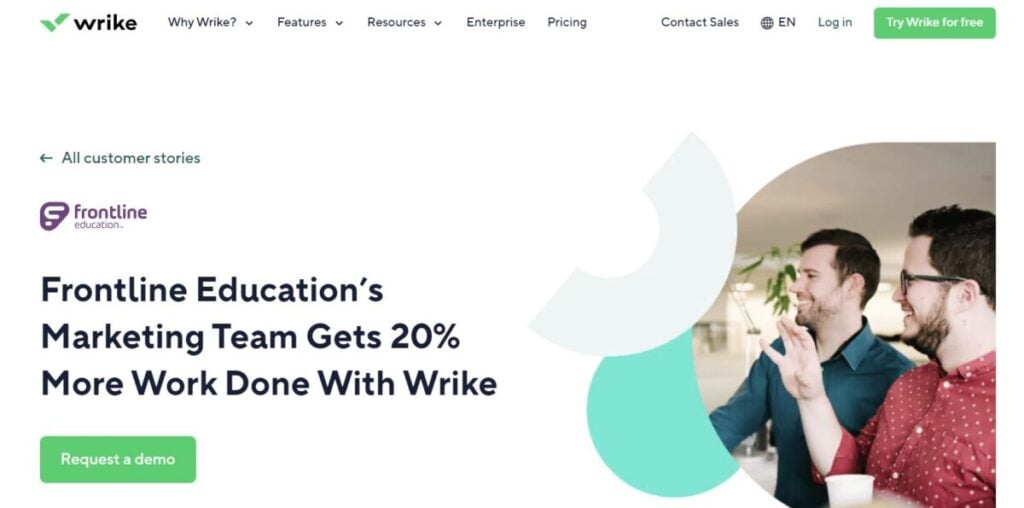
Frontline Education improved its efficiency by adopting EPM software. It was able to increase the workload it could handle by 20%. Furthermore, Frontline also managed to eliminate silos across different departments and effectively monitor employee performance.
Frontline uses Wrike to streamline internal communications. This improved the company’s efficiency and allowed teams to focus on high-impact projects. With Wrike’s Dynamic Request Forms, Frontline was able to optimize project-related requests and communications. Its Custom Workflows feature also helped users create project-specific statuses to convey a project’s progress. Lastly, with Wrike’s collaboration tools, users were able to minimize the need for sending files or feedback via email. Instead, they used mentions or comments to leave feedback or share files.
Enterprise Architecture
Digital transformation (DX) adds business value. It enables enterprises to:
- Remain competitive
- Meet evolving customer expectations
- Improve agility
- Enhance efficiency
For many global organizations, digital transformation remains a top priority. In fact, it’s estimated that spending for digital transformations will reach approximately $3.9 trillion in 2027. Key growth regions include the US, APAC, and EMEA.
Enterprise architecture (EA) is essential to digital transformation. It also covers several aspects typically associated with enterprise software solutions, such as automation and communication. Enterprise architecture tools enable organizations to create, develop, and implement robust EA systems.
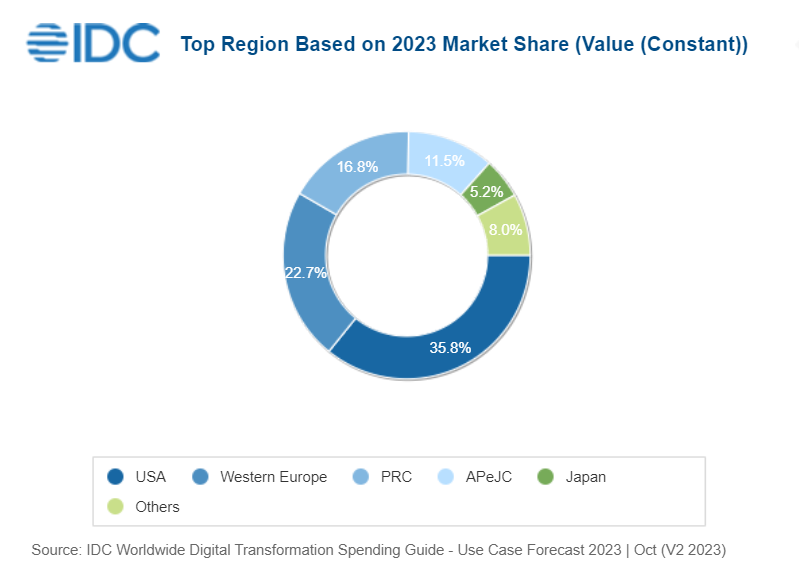
Source: idc.com
Through EA software, enterprises can have a single source of truth, model different aspects of their business for outcome delivery, and enhance data governance. Below are some examples of enterprises that have found success in leveraging EA solutions.
3. University Medical Center Groningen (UMCG)
UMCG runs a large-scale operation that involves approximately 17,000 employees. As one of the largest transplant centers in the world, it requires an internal architecture that will allow it to create streamlined workflows and more efficient processes. By implementing EA and using EA software like Ardoq, the hospital was able to overcome significant challenges and create long-term solutions such as:
- Enhancing communications to better support UMCG’s business-specific functions
- Leveraging AI to augment ongoing initiatives and bolster strategic capabilities
4. Innovation Norway
Innovation Norway, under the Norwegian Government, provides businesses with support to enable innovation and development. Through EA, Innovation Norway enhanced its capabilities, which allowed them to:
- Leverage key data for decision-making
- Enhance communication with business leaders
- Use Ardoq, an EA tool, to automate data collection
Enterprise Resource Planning (ERP)
ERP is crucial for organizations as it allows them to automate, integrate, and carry out intelligent essential operations across different departments and core processes. Enterprise resource planning systems have a centralized database that allows different modules and applications to communicate with each other. Furthermore, these systems streamline and automate core businesses, therefore enhancing productivity. They’re also capable of eliminating data silos to help businesses gather more in-depth critical insights.
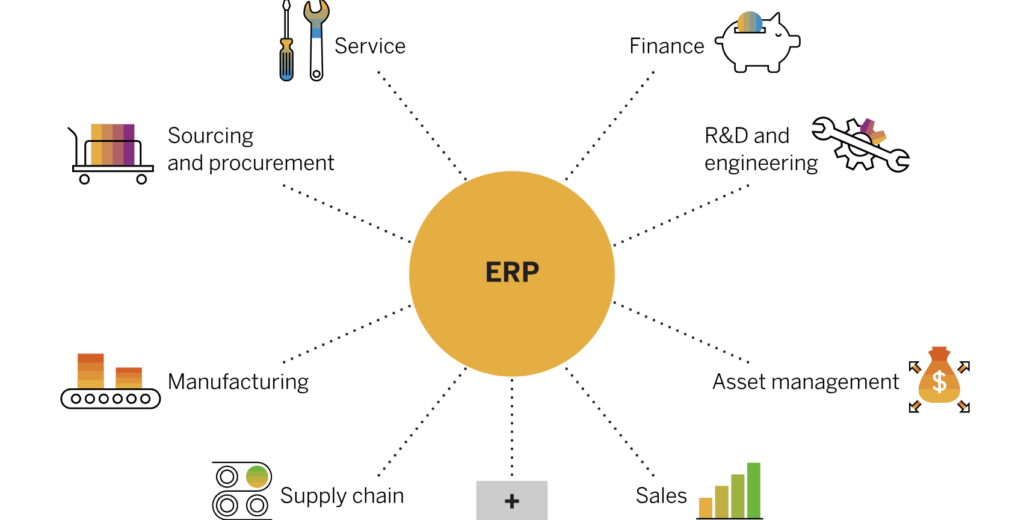
Source: sap.com
5. Herman Miller
Herman Miller is a furniture manufacturing company that has a wide network of stakeholders. These include global partners and stakeholders. The UK-based company’s global operations span over 40 countries. As the company expanded its reach to more international markets, it started to outgrow its previous systems (IT solutions, an MRP system, and a legacy ERP solution).
By implementing a new ERP system, the company was able to make significant gains. The system helped Herman Miller:
- Improve enterprise-wide workflow and collaboration
- Boost productivity
- Improve order accuracy
With the help of its new ERP system, Herman Miller achieved all of this without compromising the quality of its service and reputation. This new system also significantly enhanced its production capabilities. It allowed the company to produce up to 120 chairs in an hour, compared to its previous record of 40 chairs per hour.
6. Fulton & Roark
Fulton & Roark implemented Netsuite ERP, which allowed it to centralize all its work, identify bookkeeping mistakes, and increase sales by approximately 50% YoY.
The company initially tracked data using easily accessible tools. It used a spreadsheet to manage inventory, while desktop accounting software was used to house the company’s financial data.
However, as the business grew, the tools’ limitations became much more evident. Spreadsheets were unable to keep up with changes in inventory costs, and the desktop accounting software didn’t have proper workflows for the cost of goods sold (COGS). All of this resulted in double data entries and inaccuracies.
With Netsuite ERP, Fulton & Roark was able to centralize all its work. The company also managed to identify a large amount of inventory-related bookkeeping errors. With the implementation, Fulton & Roark didn’t have a long downtime as well. Lastly, Fulton & Roark:
- Stopped working with external accountants
- Increased its sales by approximately 50% YoY without having to increase its headcount
- Was able to accurately view its margins and inventory, which helped grow its eCommerce operation
7. Hormel Foods
Hormel Foods is a Fortune 500 company that has over 20,000 employees. Prior to implementing an ERP system, it had disjointed IT systems for different companies. This caused it to have an equally disjointed view of its performance and adversely affected its competitiveness.
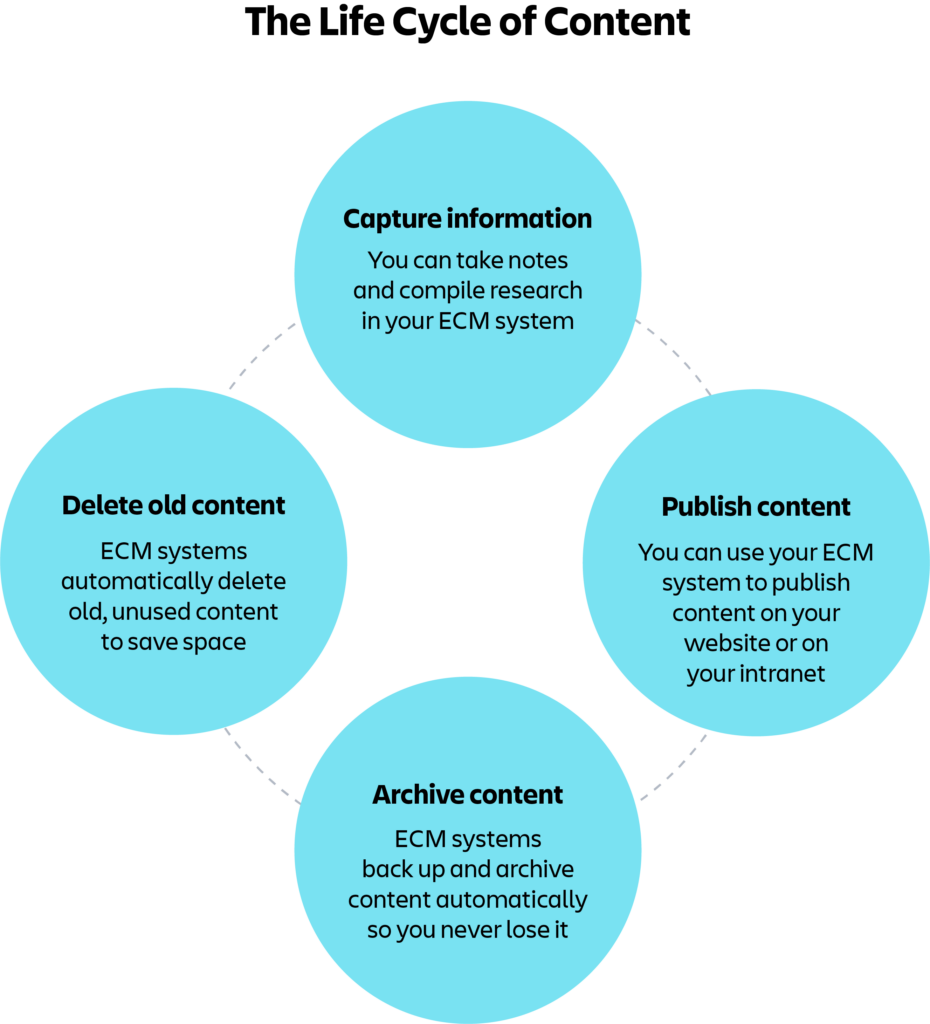
Source: atlassian.com
It worked with KPMG to implement an ERP system (Oracle Cloud ERP). This gave the entire company a unified system, which, in turn, enabled it to have standardized business processes and data. Its ERP system also helped Hormel Foods have better visibility across its different businesses.
Enterprise Content Management (ECM)
Enterprise content management helps organizations mitigate risks, promotes content security, enhances the findability of content, and provides enterprises with a repository for key documents. With ECM software, enterprises can improve their efficiency, achieve better security, and eliminate manual processes, particularly manual data entry.
8. Frost Bank
Frost Bank moved from paper-based processing for its Trust Department to a paperless one. Prior to going paperless, it faced a number of challenges, including difficulty in finding and preserving documents and servicing customers from different locations. By implementing an ECM solution, Frost Bank was able to:
- Service customers at any branch
- Documents are housed in one centralized repository
- Merge email correspondences and attachments into one document
Because of this transition, it was able to effectively shorten response times for customer inquiries, streamline document searches across different locations, and simplify document search and retrieval through data and metadata for searches.
9. Plustek, Inc.

Plustek worked with Square 9, an intelligent information management platform, to provide users with a seamless document scanning experience. With this ECM system, users can now access simpler document scanning and indexing processes. New staff can also learn how to use Plustek’s products within a shorter amount of time.
The ECM system also seamlessly integrates with Plustek’s existing workflows, which helps improve operational efficiencies. Through this, Plustek was able to simplify its document management processes. This, in turn, translated to increased customer satisfaction and enhanced user convenience. Lastly, because the system eliminated the need for multi-function printers (MFP) and desktop scanners, the company was able to save money.
Finding the Right Enterprise Software Solution for Your Business

Source: velvetech.com
Enterprise software solutions play an important role in growing your business, as they can help ensure that business processes are efficient. For companies, this means having access to a centralized or single operations system that allows them to do things more effectively. These may include running streamlined processes, having standardized policies, and bolstering enterprise capabilities.
However, there are several types of enterprise software solutions, and finding the best one for your company may seem like a challenge. Here are some helpful recommendations for finding solutions that can improve overall organizational efficiency.
- Your existing business processes. When searching for new software, consider your business processes and whether or not this new solution will suit them.
- The industry you’re in. Identify the needs of the industry you’re in. Finding enterprise software that caters to these will help ensure that the solution is capable of meeting your organization’s needs.
- Scalability. Look for an enterprise software solution that offers scalability. This ensures that if you have expansion plans in the future, your solution will still be capable of adapting to your new processes or operations.
- Robust support systems. Enterprise software solutions often come with a learning curve. Make sure that your chosen solution or vendor offers comprehensive and optimized support systems. Doing so helps ensure that your employees will be able to properly utilize your chosen solution.
Quick Guide to Choosing an Enterprise Software Solution
Identify your organization’s business needs
Before you go looking for enterprise software solutions, first identify your organization’s business needs. Check the following critical areas: processes, workflow, and departments or teams.
This helps you spot bottlenecks and identify areas where an enterprise software solution is most useful. Hold discussions with key stakeholders and end users. Get their input, particularly what their needs and requirements are.
Conduct market research
This enables you to determine if a particular solution is capable of meeting your needs. When doing market research, pay attention to the solution’s features and capabilities. A good enterprise software system should be flexible, accessible, and scalable. It should also be capable of handling seamless integrations.
Evaluate vendors
Assess the vendor’s reputation. Read case studies and customer reviews. This will help you determine if the solutions they offer are high-quality and reliable. Furthermore, it helps if you look for vendors who have prior experience providing solutions for businesses in your industry.
Assess the structure of your enterprise software candidates
Good enterprise software should be capable of seamlessly adapting to your existing physical infrastructure. Otherwise, you may need to create new infrastructure to accommodate new solutions or tools.
Determine software scalability
Scalability is a critical component of any enterprise software. A scalable enterprise software is capable of adapting to your business’s changing needs. Whether it’s in your processes or operations, a scalable solution will grow with you as your company grows.
Determine its customization and integration capabilities
These capabilities help ensure that an enterprise software solution remains flexible. For organizations, this means having access to a solution that’s capable of enhancing your strategic capabilities for business growth.
Once you’ve selected an enterprise software solution, assess the implementation process. It’s best to go with agile systems that have real-time updating capabilities. These types of systems will help you make timely and data-driven business decisions. If possible, undergo the required training so you and your team can properly and efficiently implement your new solution.
Critical Aspects to Consider
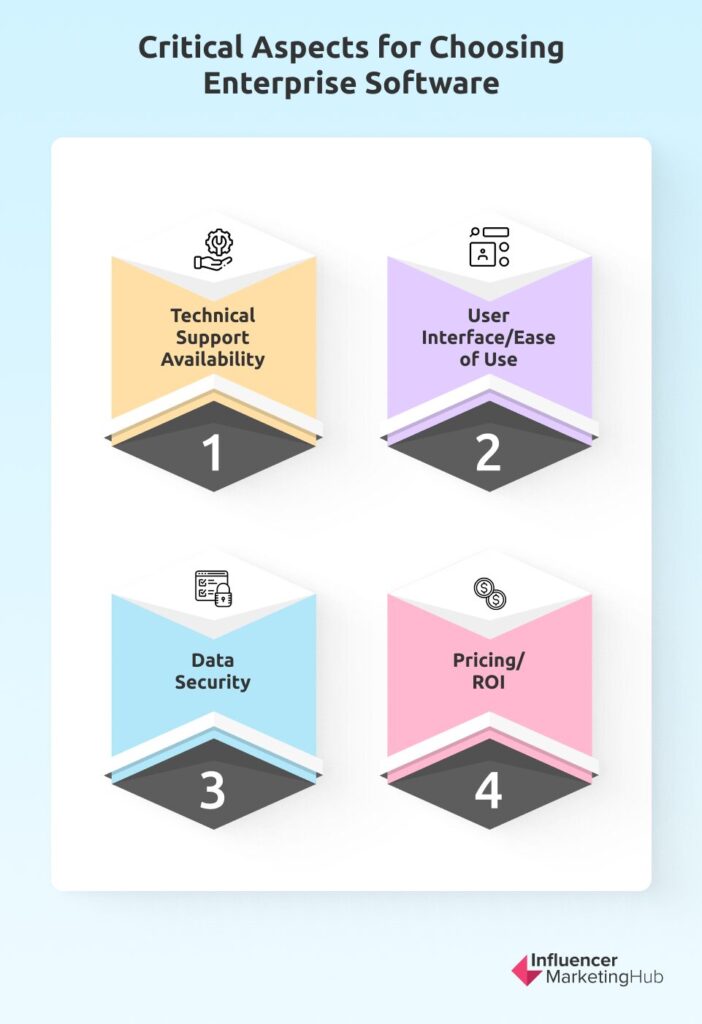
1. Technical Support Availability
Technical support during the implementation process allows you to have a seamless transition. A good ERP provider must be proactive throughout your partnership. Aside from providing you with readily available support, see if your ERP provider can give you access to additional resources like comprehensive tutorials, modules, and community support forums. Make sure that it also offers software updates and training so you can better maximize your ERP system.
2. User Interface/Ease of Use
A good ERP system should be easy to use and doesn’t entail a steep learning curve. It should also have a simple UI and UX. Focus on user adoption to improve your chances of having a more successful implementation. Make it easier for your team to use your new ERP system by providing them with sufficient training.
3. Data Security
Check if there are any measures in place to protect your data. It should have robust data protection capabilities, such as encryption and access controls.
4. Pricing/ROI
An ERP system is a major investment. Before going with a particular system and provider, ask yourself how much you’re planning to allocate for a new ERP system. Get quotes from different providers so you can determine which option best fits your organization’s needs. Given that ERP systems are also long-term investments, you must also factor in ongoing maintenance and infrastructure costs.
Fueling Business Growth with Enterprise Software
Enterprise software solutions provide businesses with systems designed to help them achieve their desired results. Using the right enterprise software, businesses can access benefits such as automation, risk mitigation, and improved operational efficiency.
By implementing these solutions, enterprises can provide their customers with enhanced experiences. Enterprise software solutions may have several types, but they’re all designed to help organizations optimize their processes and workflow. Whether you want to improve overall productivity or strengthen collaboration, enterprise software solutions are worth looking into in 2024.
Frequently Asked Questions
What are the benefits of using enterprise software?
Enterprise software solutions support daily business operations. They also help you manage complex processes and simplify workflows. Additionally, they can automate certain tasks to improve your efficiency.
Some of the areas where you can use enterprise software include customer support, project management, performance management, and risk management
What solutions can my organization use?
What you choose will depend on your business requirements, along with other related factors. Some of the most popular enterprise software solutions worth looking into include Jira, WordPress, Oracle, and Moz. Other notable solutions for enterprises include Salesforce, SAP, and HubSpot.
What different types of enterprise software are on the market?
Enterprise software solutions have several types. These include the following major types:
- Customer Relationship Management
- Enterprise Resource Planning
- Supply Chain Management Systems
- Marketing Messages Automation
- Human Resources Management
- Business Intelligence
- Business Process Management and Automation


